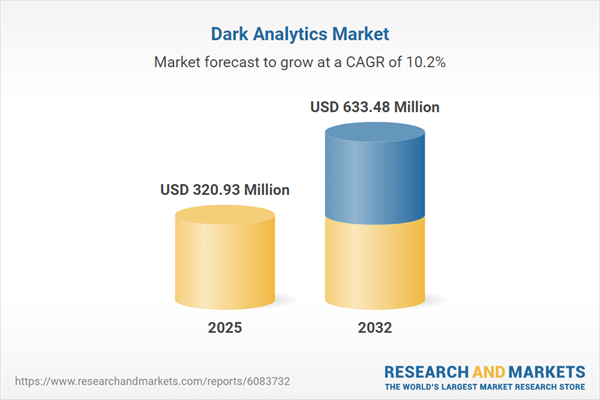Speak directly to the analyst to clarify any post sales queries you may have.
Dark analytics enables enterprises to unlock insights from untapped, unstructured datasets, transforming how organizations identify trends and drive strategy. As businesses face increasing volumes of hidden data, adopting advanced analytics becomes critical for maintaining a competitive edge.
Market Snapshot: Dark Analytics Market Size and Growth
The Dark Analytics Market grew from USD 291.14 million in 2024 to USD 320.93 million in 2025. It is expected to continue growing at a CAGR of 10.20%, reaching USD 633.48 million by 2032.
Increasing demand for extracting actionable intelligence from challenging data sources is fueling rapid adoption of dark analytics among enterprises globally. Market expansion is supported by technological advances, regulatory influences, and the pressing need for organizations to maximize business value from both structured and unstructured information.
Scope & Segmentation
- Deployment Model: Cloud (Multi Cloud, Private Cloud, Public Cloud), Hybrid, On Premises (Hardware, Software)
- Data Type: Structured, Semi Structured, Unstructured (Image, Text, Video)
- Organization Size: Large Enterprise, Sme
- Industry Vertical: Bfsi, Healthcare, Manufacturing, Retail
- End User: Business Analyst, Cio, Data Scientist, It Manager
- Geographic Reach: Americas (North America: United States, Canada, Mexico; Latin America: Brazil, Argentina, Chile, Colombia, Peru), Europe, Middle East & Africa (Europe: United Kingdom, Germany, France, Russia, Italy, Spain, Netherlands, Sweden, Poland, Switzerland; Middle East: United Arab Emirates, Saudi Arabia, Qatar, Turkey, Israel; Africa: South Africa, Nigeria, Egypt, Kenya), Asia-Pacific (China, India, Japan, Australia, South Korea, Indonesia, Thailand, Malaysia, Singapore, Taiwan)
- Key Companies: Splunk Inc., International Business Machines Corporation, Micro Focus International plc, LogRhythm, Inc., Rapid7, Inc., Securonix, Inc., Exabeam, Inc., Elastic N.V., Devo, Inc., Sumo Logic, Inc.
Solutions span from cloud-native deployments to on-premises systems, meeting diverse compliance, security, and performance needs. Industry verticals tailor approaches using structured, semi-structured, and unstructured data, leveraging image analysis, natural language processing, and video analytics for enhanced outcomes.
Key Takeaways: Strategic Insights for Senior Decision-Makers
- Dark analytics empowers organizations to uncover hidden trends and correlations from massive, underutilized data sources, fostering more informed and agile decision-making.
- Widespread adoption is reshaping data architectures, with firms combining real-time analysis and historical data review for holistic business intelligence.
- Cutting-edge AI technologies and machine learning frameworks are automating pattern recognition, anomaly detection, and actionable insight delivery across industries.
- Successful implementation depends on cross-functional collaboration, robust governance standards, and continuous upskilling of data literacy across teams.
- Emergence of end-user-facing visualization and self-service platforms is democratizing access to complex analytics, enabling business leaders to quickly derive value without deep coding expertise.
- Regional demand varies, with North America and Asia-Pacific driving innovation, while Europe and the Middle East prioritize data sovereignty and compliance.
Tariff Impact: Navigating United States Tariff Effects
Newly imposed United States tariffs are increasing procurement and operational costs for dark analytics solutions, affecting hardware and licensing expenses. Enterprises are responding by reassessing vendor choices and considering open-source or cloud-based alternatives, which may bring new compliance and performance considerations. This dynamic is prompting diversification strategies across public, private, and hybrid deployments to mitigate risk and maintain flexibility.
Methodology & Data Sources
This report leverages a balanced approach of primary research, including interviews with stakeholders and industry leaders, and secondary analysis of credible publications, regulatory documents, and anonymized datasets. Rigorous frameworks such as scenario planning and SWOT analysis ensure findings are robust and validated.
Why This Report Matters
- Gain a clear understanding of current dark analytics market opportunities, risks, and evolving technologies for strategic investment planning.
- Evaluate competitor positioning and benchmark organizational readiness based on regional and vertical segmentation insights.
- Make informed decisions about solutions that provide measurable business value while satisfying compliance and governance standards.
Conclusion
Dark analytics is transforming enterprise strategy, enabling data-driven leadership in a dynamic business landscape. Leaders who prioritize adoption and continuous learning are positioned for sustained growth and improved operational agility.
Table of Contents
3. Executive Summary
4. Market Overview
7. Cumulative Impact of Artificial Intelligence 2025
Companies Mentioned
The companies profiled in this Dark Analytics market report include:- Splunk Inc.
- International Business Machines Corporation
- Micro Focus International plc
- LogRhythm, Inc.
- Rapid7, Inc.
- Securonix, Inc.
- Exabeam, Inc.
- Elastic N.V.
- Devo, Inc.
- Sumo Logic, Inc.
Table Information
| Report Attribute | Details |
|---|---|
| No. of Pages | 180 |
| Published | October 2025 |
| Forecast Period | 2025 - 2032 |
| Estimated Market Value ( USD | $ 320.93 Million |
| Forecasted Market Value ( USD | $ 633.48 Million |
| Compound Annual Growth Rate | 10.2% |
| Regions Covered | Global |
| No. of Companies Mentioned | 11 |









